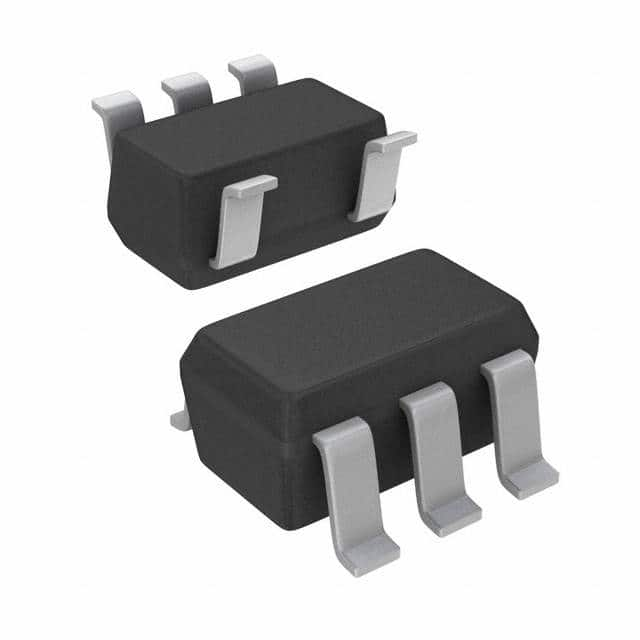SN74LVC1G00DBVR
Product Overview
- Category: Integrated Circuit (IC)
- Use: Logic Gate
- Characteristics: Single 2-Input NAND Gate
- Package: SOT-23-5
- Essence: High-Speed CMOS Technology
- Packaging/Quantity: Tape and Reel, 3000 pieces per reel
Specifications
- Supply Voltage Range: 1.65V to 5.5V
- Input Voltage Range: 0V to VCC
- Output Voltage Range: 0V to VCC
- Maximum Operating Frequency: 100 MHz
- Propagation Delay: 3.8 ns (typical)
- Low Power Consumption: 10 µA (maximum)
Detailed Pin Configuration
The SN74LVC1G00DBVR has a total of five pins:
- GND (Ground): Connected to the ground reference potential.
- A (Input A): First input terminal for the NAND gate.
- B (Input B): Second input terminal for the NAND gate.
- Y (Output): Output terminal for the NAND gate.
- VCC (Supply Voltage): Connected to the positive supply voltage.
Functional Features
- High-Speed Operation: The SN74LVC1G00DBVR utilizes high-speed CMOS technology, allowing for fast switching times and improved performance.
- Wide Voltage Range: It can operate within a wide supply voltage range of 1.65V to 5.5V, making it compatible with various systems.
- Low Power Consumption: With a maximum current consumption of only 10 µA, this IC is energy-efficient and suitable for battery-powered applications.
- Schmitt Trigger Inputs: The inputs are equipped with Schmitt trigger hysteresis, ensuring reliable operation even in noisy environments.
- ESD Protection: The device offers electrostatic discharge (ESD) protection, safeguarding it against potential damage during handling and assembly.
Advantages and Disadvantages
Advantages: - Compact Size: The SOT-23-5 package allows for space-saving integration in small-scale designs. - Versatile Application: The NAND gate's versatility makes it suitable for a wide range of digital logic applications. - High-Speed Operation: The IC's fast switching times enable efficient data processing.
Disadvantages: - Single Gate Functionality: The SN74LVC1G00DBVR only contains a single 2-input NAND gate, limiting its application to specific scenarios. - Limited Output Current: The output current capability is relatively low, which may restrict its use in certain high-current applications.
Working Principles
The SN74LVC1G00DBVR is a single 2-input NAND gate that performs logical AND operation followed by a logical NOT operation. It accepts two input signals, A and B, and produces an inverted output signal, Y. The output is LOW only when both inputs are HIGH; otherwise, the output remains HIGH.
The IC operates on high-speed CMOS technology, utilizing MOSFET transistors to achieve fast switching times and low power consumption. The Schmitt trigger inputs ensure reliable operation by providing hysteresis and noise immunity.
Detailed Application Field Plans
The SN74LVC1G00DBVR finds applications in various digital logic circuits, including but not limited to:
- Signal Processing: It can be used in signal conditioning circuits, amplifiers, and filters.
- Data Communication: The NAND gate is commonly employed in UART (Universal Asynchronous Receiver-Transmitter) interfaces and serial communication protocols.
- Control Systems: It plays a vital role in control systems, such as motor control, robotics, and industrial automation.
- Memory Circuits: The NAND gate is utilized in memory address decoding and data storage circuits.
- Clock Generation: It can be employed in clock generation and synchronization circuits.
Detailed and Complete Alternative Models
- SN74LVC1G00DCKR: SOT-353 package, 3000 pieces per reel.
- SN74LVC1G00DRLR: SOT-553 package, 2500 pieces per reel.
- SN74LVC1G00YZPR: DSBGA package, 3000 pieces per reel.
- SN74LVC1G00DCKT: SC-70 package, 3000 pieces per reel.
- SN74LVC1G00DRLRG4: SOT-553 package, 2500 pieces per reel.
These alternative models offer similar functionality and characteristics to the SN74LVC1G00DBVR, providing options for different package types and quantities.
In conclusion, the SN74LVC1G00DBVR is a single 2-input NAND gate IC that operates on high-speed CMOS technology. Its compact size, wide voltage range, and low power consumption make it suitable for
قم بإدراج 10 أسئلة وإجابات شائعة تتعلق بتطبيق SN74LVC1G00DBVR في الحلول التقنية
Sure! Here are 10 common questions and answers related to the application of SN74LVC1G00DBVR:
Q1: What is SN74LVC1G00DBVR? A1: SN74LVC1G00DBVR is a single 2-input NAND gate IC (integrated circuit) manufactured by Texas Instruments.
Q2: What is the voltage supply range for SN74LVC1G00DBVR? A2: The voltage supply range for SN74LVC1G00DBVR is typically between 1.65V and 5.5V.
Q3: What is the maximum output current of SN74LVC1G00DBVR? A3: The maximum output current of SN74LVC1G00DBVR is around 32mA.
Q4: Can SN74LVC1G00DBVR be used in battery-powered applications? A4: Yes, SN74LVC1G00DBVR can be used in battery-powered applications due to its low power consumption.
Q5: What is the operating temperature range for SN74LVC1G00DBVR? A5: The operating temperature range for SN74LVC1G00DBVR is typically between -40°C and 125°C.
Q6: Is SN74LVC1G00DBVR suitable for high-speed applications? A6: Yes, SN74LVC1G00DBVR is designed for high-speed operation and can be used in various high-frequency applications.
Q7: Can SN74LVC1G00DBVR be used as a level shifter? A7: Yes, SN74LVC1G00DBVR can be used as a level shifter to convert signals between different voltage levels.
Q8: How many inputs does SN74LVC1G00DBVR have? A8: SN74LVC1G00DBVR has two inputs, making it a 2-input NAND gate.
Q9: What is the typical propagation delay of SN74LVC1G00DBVR? A9: The typical propagation delay of SN74LVC1G00DBVR is around 3.5 nanoseconds.
Q10: Can SN74LVC1G00DBVR be used in both digital and analog circuits? A10: No, SN74LVC1G00DBVR is primarily designed for digital applications and may not be suitable for analog circuits.
Please note that these answers are general and may vary depending on specific datasheet specifications and application requirements.


